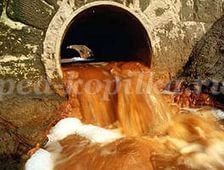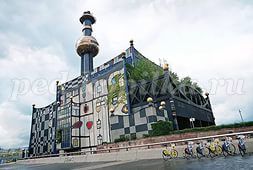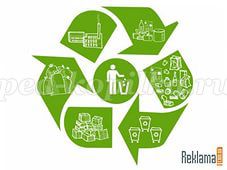Ecological conversation for students in grades 5-7 with a presentation
Ecological talk "Garbage is a global problem".
Relevance of the topic: Planet Earth is our common home, every person living in it should carefully and carefully treat it, preserving all its values and wealth.Material Description: This year I was faced with the task of telling the children about the ecology of our region. I bring to your attention several conversations about ecology, designed for children in grades 5-7, this material can also be useful to teachers, educators and parents.
Recommendations: The conversation is accompanied by a presentation (multimedia accompaniment), which allows you to better feel the degree of danger from pollution of our Home-Earth. The conversation begins with showing an excerpt from the cartoon "Wally", followed by a problem statement. You can play the question or ask the children to ask it, or ask the teacher (this is the envy of the class).
Target: To form in children knowledge about various types of household pollution. To arouse the desire of schoolchildren to protect nature, to set the stage for the implementation of some measures for nature protection.
Tasks:
- to study the scale of the problem;
- analyze modern methods of waste disposal;
- find rational ways to dispose of waste.
The course of the conversation.
The cartoon should stop at 2 minutes and ask the question: "What did you see in this passage?"
Sample responses from children:
- mountains of rubbish
- an empty planet
- a robot that collects garbage ...
Teacher's question: "Why is the planet empty, what happened? What is the reason?"
Sample responses from children:
-People flew away because they littered the planet and could not live on it.
Now look under your desks (look at the sidewalk...or any other example..is there a job for Wally?
Our settlement arose in 1921, on the bank of the river. Several houses were built. The first inhabitants saw a beautiful forest around, fertile meadows, carpets of fields. The village grew. And what do we see now? What happened as a result? ( Children's answers)
Today we will talk with you about garbage, we will try to figure out how dangerous our household garbage is.
Presentation display.
Garbage is a global problem.
2 slide. For every inhabitant of our planet, there is an average of about 1 ton of garbage per year.3 slide.
Causes of garbage:
. growth in single-use production;
An example for clarity: disposable tableware that is used on hikes, picnics, etc.
. increase in the amount of packaging;
An example for clarity: a box of chocolates. To get to a handful of sweets, we first remove the film, then open the lid of the box, then remove the paper, and take out the candies from individual packages. As a result, there are only 6-12 sweets, and a full bucket of garbage!
. raising the standard of living, allowing usable things to be replaced by new ones.
An example for clarity: almost every day, new phones are offered to us from the TV screen, and we have a desire to buy a new thing, although the old phone is serviceable and functional. Where do we put the old phone when we get a new one?
4 slide. Municipal solid waste(MSW, household waste) - items or goods that have lost consumer properties, the largest part of consumer waste
MSW: paper, glass, food waste, plastics, fabrics, metal objects. In addition to all this, large-sized solid waste (garbage - old furniture, broken household appliances, car tires, etc.)
5 slide. Conventionally, all produced waste can be divided into 4 categories. (description on slide)
Inert - Possessing low chemical activity; difficult to enter into chemical reactions.
Waste is also classified according to the degree of danger to the environment. The classification goes on increasing from grade 5 to grade 1.
Class 1: Extremely hazardous waste. The threat is very high, at this level the ecological system is irreversibly damaged, there is no recovery period.
Class 2: Highly hazardous waste. The threat to the environment is high. Restoring the ecological balance is possible in 30 years.
Grade 3: Moderately hazardous waste. The ecological system is broken. Restoration of the ecological system is possible not less than 10 years after the reduction or elimination of the harmful source.
Class 4: Low hazardous waste. There is an environmental impact. Restoration of the environment for at least 3 years.
Grade 5: Practically not dangerous. There is no environmental impact.
6 slide. Construction and household waste

Construction waste. This type of waste is generated during construction and installation works for various purposes, in particular the construction of large facilities, road works, as well as during the dismantling and demolition of premises. Most often, such waste includes solidified lump-shaped solutions, crushed stone, broken bricks, rebar, wood debris, scrap metal, and others. These wastes are classified as 3-4 hazard classes.
Household waste.

Household waste is generated in the process of human activity, as a rule, in institutions, residential complexes, private sectors, municipal institutions, and so on. This type of waste includes food waste, plastic, paper, furniture, glass, clothing and other household waste. This kind of garbage has hazard class 4-5.
7 slide. Industrial wasteIndustrial waste.

These are various types of waste that are generated as a result of production work and technological processes. Garbage has hazard class 2-3.
In addition to waste generated as a result of the activities of the population and enterprises, wastewater also includes water, the formation of which was the result of various atmospheric precipitation on the territory of industrial facilities and settlements.
Various organic substances contained in wastewater, when released into water bodies, begin to rot and cause a deterioration in the sanitary condition of both the water bodies themselves and the surrounding air, and also become sources of the spread of pathogenic bacteria.
Therefore, the most important issues of environmental protection are water disposal and wastewater treatment, which prevent harm to public health and the ecological situation of settlements.
8 slide. Chemical compounds and rubber

Chemical - pollutants are harmful chemical compounds. 1 class of danger.
9slide. Packaging materials (plastic bags, plastic bottles, aluminum cans)
10 slide. There are three ways to dispose (description on slide)
Exercise "My portfolio"
(individually, in groups, as a whole class)
Children take out things, objects from their portfolios and sort them, laying out separately objects made of wood (paper), metals, fabrics, glass, plastics. Under the guidance of the teacher, they write the data into a table, writing out the contents of the portfolio in the appropriate columns. Further discussion: are there many products and what material are they made of? How long will these things last? How quickly will they end up in a landfill? Is there anything we can do to keep them from becoming garbage?
11 slide. Landfills are the most anti-environmental way to recycle waste.

In an ordinary landfill, toxic infiltration water flows out of it, and methane enters the atmosphere, which contributes to an increase in the greenhouse effect (today, methane "takes on" 20% of the climate warming effect)
In a notebook
b:
1. Poisonous substances penetrate into groundwater, are dispersed by winds in the surroundings, and thereby cause damage to the environment.
2. As a result of decay processes without air access, various gases are formed
3. Fires regularly occur at landfills, during which soot, phenol and other toxic substances are released into the atmosphere.
12 slide. When constructing a waste site, the following shall be taken into account:
-rose, winds in the landfill area;
- distance from settlements, water protection and nature protection zones;
- permeability of soils;
- the area of the territory allotted for the landfill (the area should be sufficient to receive garbage for a long time);
- location convenient for transport access
13 slide. As a variant of the landfill, a landfill for the storage of solid waste is proposed - this is a “bath” with a bottom and sides made of clay and polyethylene film, in which the compacted layers of solid waste are sprinkled with layers of soil. The volume of garbage is growing so fast that in a few years any landfill is full and a new one needs to be built.
Does the landfill of our village meet all the requirements? Why?
14 slide. Unauthorized dumps(Where can these dumps be seen in the village? near it?)
1. Disfigures the landscape.
2. Creates a threat to human health:
- breeding rodents are carriers of infectious diseases;
- toxicological hazard from escaping methane, sulfur dioxide.
3. The released biogas creates an explosion and fire hazard.
4. Contamination of soil and groundwater with compounds of arsenic, cadmium, chromium, lead, mercury, nickel.
15 slide. Construction debris fall asleep ravines and I
we.
-Firstly, such landfills are drained to prevent the ingress of water from the landfill into underground aquifers.
-Secondly, they are ventilated to prevent the formation of combustible and poisonous gases.
-Thirdly, the garbage is poured into the landfill so that its surface is even.
16 side. Waste incineration.

- Harmful or toxic chemical compounds are released in huge quantities.
-not all trash is on fire
-garbage contains a lot of moisture and hardly combustible materials
17 slide: There are waste incineration plants: 1 ton of garbage can produce 400 kWh (energy - hot steam). However, even with the most advanced combustion technology, these plants pollute the atmosphere. Although an environmentally friendly incineration plant was built in Vienna.

The building with golden spherical domes, a high chimney tower and colorful walls houses the Spittelau waste incineration plant (Hundertwasser's creation), which has become an organic element of the urban landscape, an example of high environmental standards and a popular tourist attraction. The Spittelau incinerator is a rare combination of practicality and beauty. The plant can dispose of 265,000 tons of garbage annually. He generates electricity for his own needs. In addition, it supplies heat to 60,000 Viennese apartments. Mirrored golden balls crowning the factory chimneys are not just eye-catching architectural decorations, but effective filters that remove heavy metals, acids and sulfur dioxide from smoke. These devices cost the treasury a lot (the cost of the project almost doubled because of them), but the author of the project insisted on installing them. Now there are no unpleasant odors in the vicinity of the plant.
18 slide: Recycling is the most resource-saving way.

-First problem: garbage needs to be sorted. For recycling, investments are needed to make waste processing plants economically viable.
- The second problem: the delivery of garbage to the place of processing.
-Third problem: garbage cannot be used as a raw material for the production of high-quality products. Although it is profitable to process MSW, there is always a demand for secondary raw materials - paper, glass, plastic, aluminum, non-ferrous metals, etc.
19 slide. Moreover
1.Industrial waste - must not be disposed of together with household waste,
- pesticides, mercury and its compounds - chemical industry waste;
-radioactive waste generated at nuclear power plants;
- arsenic and its compounds - waste from metallurgical industries and thermal power plants;
lead compounds - waste from the oil refining and paint industries, etc.
20 slide. 2.Household waste - which after their use becomes special waste.
-batteries;
- unused medicines;
- residues of chemical plant protection products (toxic chemicals);
- the remains of paints, varnishes and glues;
-remains of cosmetics (eyeshadow, nail polish, nail polish remover);
- residues of household chemicals (cleaning products, deodorants, stain removers, aerosols, furniture care products);
- mercury thermometers.
21 slide.Liquidation (utilization) of special waste is regulated by strict rules and regulations:
- Incineration in special installations,
-Placement on special grounds
- Storage on the ground in a waterproof platform up to 3 m thick.
22 slide. The recycling of solid waste in Russia is no more than 2%; one of the reasons is the insufficient ecological culture of the population. After all, it is easier for us to throw garbage into a common container than to sort it. And the dirtiest trash is food waste.. They decompose and pollute the other, and it becomes more difficult to sort out.
22 slide. Natural decomposition of garbage:
- paper - from 2 to 10 years,
- tin can - 90 years,
- a filter from a cigarette - 100 years, a plastic bag - 200 years, plastic - 500 years,
- glass - 1000 years.
24slide. As we have already said, the most environmentally friendly way to get rid of garbage is its recycling. Your options (children give examples of recycling garbage)
-The Dutch are building an island out of garbage in the Pacific Ocean
- Build houses from bottles (glass)
-Establish fences, Create sculptures
25-27 slide: Waste recycling (examples on slide)
Exercise "Useful garbage"
(frontal)
Find garbage in pictures or in your things that can be recycled.
Garbage sorting game.
(in groups)
Children in groups sort garbage into fractions, deciding for themselves which fractions to allocate. It is possible to replace the "real" garbage with cards. Discussion of the results of the work.
28 slide. Active pollution of the environment has led to a global environmental problem - the destruction of the human environment.
29 slide. Let's come up with rules that we will follow to keep our planet clean.
1. Throw garbage only into containers;
2. When shopping, take a shopping bag with you;
3. Try to buy detergents that do not contain phosphates;
4.Do not throw garbage in sinks and toilets;
5. Use compost and manure as organic fertilizers;
6. Whenever possible, buy drinks in glass bottles;
7. Try to avoid buying disposable items.
30 slide.
- Is scientific and technological progress justified? After all, by improving the conditions of our life, it inevitably leads to a disaster for the natural environment.
- Increasing anthropogenic pressure may eventually lead to the extinction of humanity as a biological species.
- And one of the reasons for this is garbage ...
Exercise "Alternative"
(in groups or as a whole class)
It is necessary to offer alternatives to various things that very quickly become garbage. How can they be made differently so that there is less garbage?
- plastic bag for milk, kefir
-disposable tableware
- plastic lemonade bottle
-batteries
-other, from what the children themselves called during the conversation.
Final discussion.
Our civilization is sometimes called the civilization of waste. Never before in the history of mankind have landfills grown so rapidly! If the garbage of earthlings is put in one place in one year, then a real mountain will form, like Mont Blanc. What can you and I do so that at least Valli does not have to work in our village?
